Effects of changes in body composition on cardiometabolic diseases by sex and presence of sarcopenia
IF 3.9
2区 医学
Q2 GERIATRICS & GERONTOLOGY
引用次数: 0
Abstract
Background
Muscle mass loss and fat mass increase are risk factors for cardiometabolic disease. We evaluated the effect of changes in body composition on the incidence of cardiometabolic diseases in older adults with or without sarcopenia, over two-year follow-up.
Materials and methods
Changes in body composition and the development of cardiometabolic diseases over 2 years were measured in community-dwelling older adults recruited from the Korean Frailty Aging Cohort Study. Individuals with sarcopenia were 1:1 matched to those without sarcopenia via propensity score matching.
Results
Among a total of 1634 eligible subjects, 353 were identified with sarcopenia. In men without sarcopenia, an increase in waist circumference by 1 cm was associated with a 32 % higher risk of the development of hypertension. Conversely, an increase in appendicular lean mass by 1 kg was associated with lower risks of the development of cardiovascular disease (41 % lower) and hyperlipidemia (28 % lower). However, there were no significant associations between changes in body composition and any incident cardiometabolic diseases in men with sarcopenia. Women without sarcopenia who experienced an increase in weight of 1 kg were 21 % less likely to develop hyperlipidemia. In women with sarcopenia, the risk of diabetes mellitus was reduced by 30 % with an incremental increase in weight by 1 kg, while the risk of hyperlipidemia increased almost threefold with an increase in appendicular lean mass by 1 kg.
Conclusions
In older adults without sarcopenia, a decrease in obesity-related indices and a gain in muscle gain are beneficial for men, but inverse relationships between weight and cardiometabolic diseases were reported in women. We found no cardiometabolic benefit of increasing lean mass in older adults with sarcopenia regardless of sex.

性别和肌肉减少症对身体组成变化对心脏代谢疾病的影响
背景:肌肉量减少和脂肪量增加是心脏代谢疾病的危险因素。我们在两年的随访中评估了身体成分变化对患有或不患有肌肉减少症的老年人心脏代谢疾病发病率的影响。材料和方法:从韩国衰弱老龄化队列研究中招募的社区居住老年人,在2年内测量了身体成分的变化和心脏代谢疾病的发展。通过倾向评分匹配,骨骼肌减少症患者与非骨骼肌减少症患者的比例为1:1。结果:在1634名符合条件的受试者中,353人被确定为肌肉减少症。在没有肌肉减少症的男性中,腰围每增加1厘米,患高血压的风险增加32%。相反,阑尾瘦质量每增加1公斤,患心血管疾病(降低41%)和高脂血症(降低28%)的风险降低。然而,在患有肌肉减少症的男性中,身体成分的变化与任何突发的心脏代谢疾病之间没有显著的关联。没有肌肉减少症的女性体重增加1公斤,发生高脂血症的可能性降低21%。在患有肌肉减少症的女性中,体重每增加1公斤,患糖尿病的风险降低30%,而阑尾瘦体重每增加1公斤,患高脂血症的风险增加近三倍。结论:在没有肌肉减少症的老年人中,肥胖相关指数的下降和肌肉增加的增加对男性有益,但在女性中,体重与心脏代谢疾病呈反比关系。我们没有发现增加老年肌肉减少症患者的瘦质量对心脏代谢有好处,无论性别如何。
本文章由计算机程序翻译,如有差异,请以英文原文为准。
求助全文
约1分钟内获得全文
求助全文
来源期刊

Maturitas
医学-妇产科学
CiteScore
9.10
自引率
2.00%
发文量
142
审稿时长
40 days
期刊介绍:
Maturitas is an international multidisciplinary peer reviewed scientific journal of midlife health and beyond publishing original research, reviews, consensus statements and guidelines, and mini-reviews. The journal provides a forum for all aspects of postreproductive health in both genders ranging from basic science to health and social care.
Topic areas include:• Aging• Alternative and Complementary medicines• Arthritis and Bone Health• Cancer• Cardiovascular Health• Cognitive and Physical Functioning• Epidemiology, health and social care• Gynecology/ Reproductive Endocrinology• Nutrition/ Obesity Diabetes/ Metabolic Syndrome• Menopause, Ovarian Aging• Mental Health• Pharmacology• Sexuality• Quality of Life
 求助内容:
求助内容: 应助结果提醒方式:
应助结果提醒方式:


